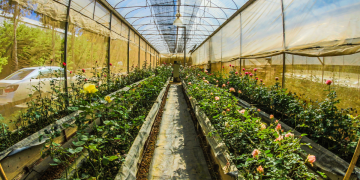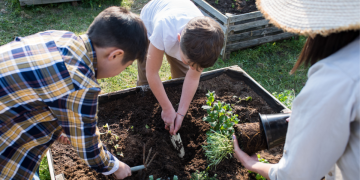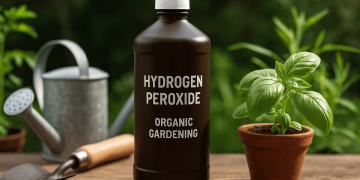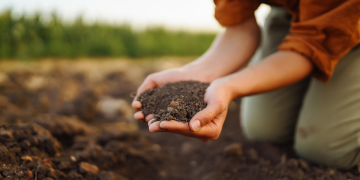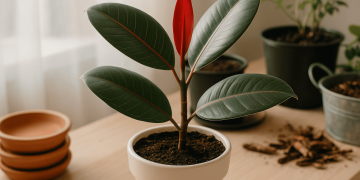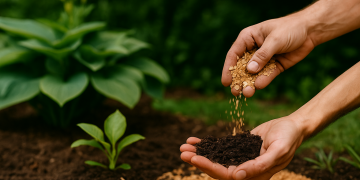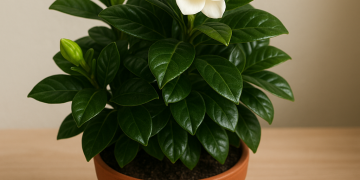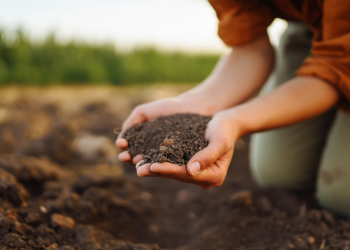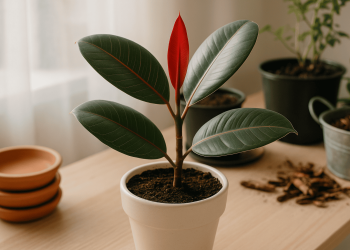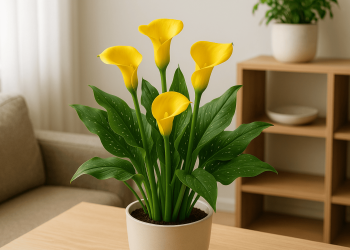Table of Contents
ToggleSetting Up the Perfect Indoor Environment for Healthy and Flowering Gardenias
Achieving beautiful blooms from your indoor gardenia begins with replicating the natural conditions these finicky plants love in the wild. Let’s break down the essentials so you know exactly how to take care of a gardenia plant indoors—and more importantly, how to spot when your home needs fine-tuning.
The first—and perhaps the most critical—factor is light. Gardenias demand bright, indirect light to thrive. The best spot? Near an east- or south-facing window, where gentle morning or filtered sunlight pours in. Direct, harsh midday rays can scorch those iconic dark green leaves and lead to gardenia yellow leaves or even bud drop. Most forms of gardenia not blooming indoors are a clear sign your plant isn’t getting the light it craves. If your space is shaded, supplemental grow lights are a wise investment.
Temperature is another non-negotiable. Gardenias prefer steady warmth: aim for 18–24 °C (65–75 °F) during the day, with a slight drop at night. Drafts, sudden temperature shifts, or cold windowsills can cause stress (another common culprit for gardenia bud drop) and slow flower production, so try to pick a spot away from heating vents or exterior doors. Maintaining these “just right” conditions is fundamental in any guide about how to get gardenia to bloom successfully indoors.
When it comes to humidity for gardenia, consistency is your best friend. Gardenias are extremely sensitive to dry air. If your climate is arid, using a small humidifier can make all the difference, or you can set the pot atop a shallow tray filled with water and pebbles. You’re aiming for at least 55–60% humidity. Regular misting can help, but always avoid water pooling on the leaves, as this can encourage gardenia pests and diseases.
Soil and pH close the list of essentials. Your plant will thank you for a loose, airy, acidic soil—in fact, the sweet spot is a pH between 5 and 6. The simplest option is purchasing a pre-mixed substrate for azaleas or camellias, designed specifically for acid-loving species. Avoid garden soil or mixes that feel heavy or contain added lime, as these can lock up nutrients, resulting in sad, yellowed foliage and diminished blooms. If you’d like to tailor your own mix or need to repot gardenia, there are advanced recipes and step-by-step guides for composting aficionados—just know that a good-quality, ready-made acid-loving mix will serve most gardeners well.
Related Article
Is your soil drying out too fast? Learn how to make your potting mix retain more water and keep your gardenia healthier for longer.
👉 How to Make Your Soil Retain More Water: Practical Solutions for Home Gardens
Identifying whether your current setup meets these needs isn’t difficult. Pay attention to your plant’s appearance: are the leaves glossy and deep green, or pale and limp? Are flower buds forming or dropping off without opening? Small investments—a light meter, basic humidity sensor, or soil pH tester—can take the guesswork out of indoor gardenia care and transform a “surviving” plant into one that thrives and flowers reliably.

Creating this perfect indoor environment isn’t about advanced horticulture—just about attention to a few essential details. With a focus on light, temperature, humidity, and the right soil, you’re well on your way to how to grow gardenia that flower and flourish right inside your home.
Daily Gardenia Care Indoors: Watering, Fertilizing, Pruning and Basic Repotting
Caring for your indoor gardenia need not feel daunting. A simple, consistent routine is key to encouraging lush foliage and blooming cycles—even if you’ve previously struggled with issues like gardenia not blooming or yellow leaves. Here’s how to care for gardenia daily and weekly, giving your plant what it needs without unnecessary complications.
When it comes to watering, regularity and moderation are vital. Gardenias thrive in moist but not soggy soil. Gently press your finger to the surface—if it feels dry, it’s time to water. Use lukewarm, non-calcareous water to avoid mineral build-up, and always water directly at the base. Overwatering is a common pitfall leading to gardenia yellow leaves and root rot. Be sure your pot drains well and empty the saucer after watering.

Fertilizing gardenia should be deliberate and seasonally timed. Throughout spring and summer—the plant’s major growth and bloom period—apply a liquid or granular fertilizer formulated especially for acid-loving plants every three to four weeks. Inappropriate fertilization, such as using general-purpose or overly frequent feedings, can lead to more harm than good and may even contribute to gardenia bud drop or persistent gardenia not blooming indoors.
Pruning is neither complex nor time-consuming if kept routine. Focus on removing spent flowers and any weak, dry, or tangled stems. Doing so stimulates healthy new shoots and helps maintain a compact, attractive form. Use sharp, sterilized pruning scissors for neat cuts and to minimize disease risk. Pruning is never about reshaping drastically, but about gentle tidying for vigour.

If you notice your gardenia has outgrown its pot or the soil is compacted and drains poorly, consider repotting. Generally, gardenias benefit from fresh soil and a slightly larger container every two or three years—no more, unless clear symptoms arise. More frequent repotting or attempting advanced techniques isn’t necessary for routine care.
Those interested in expanding their gardenia collection might explore propagation by cuttings, but this involves techniques best covered in detailed guides. For now, focus on mastering the daily basics and enjoying the steady progress of your plant.
By attending to watering, fertilizing, pruning and occasional basic repotting, you’ll address the most frequent causes of gardenia not blooming and lay the groundwork for continual flowering—even in indoor conditions. If you face issues like gardenia bud drop, gardenia pests and diseases, or maintaining humidity indoors, adjusting these routines is often the first and most effective remedy.
Troubleshooting Common Indoor Gardenia Problems: Yellow Leaves, Bud Drop, and Pests
Caring for gardenias indoors is a journey filled with fragrant promise, but it’s common to encounter a few stumbling blocks along the way. One of the most frequent warning signs is yellow leaves. This symptom usually points to overwatering, iron deficiency, or a potting mix pH that’s too high for acid-loving plants like gardenias. When you notice gardenia yellow leaves, check that the pot drains well and the roots aren’t waterlogged. Switching to a fertilizer formulated for acid-loving species can help restore your plant’s lush green. Adjusting the pH of your potting soil may also be necessary—gardenias truly thrive when their roots nestle in an acidic environment.

Another challenge indoor gardeners report is bud drop—when tightly closed gardenia buds fall off before they have a chance to bloom. This gardenia bud drop is most often triggered by sudden temperature shifts, dry air, or even inconsistent watering. Protect your plant from cold drafts or heaters, and keep humidity levels steady. Using a pebble tray or a small humidifier nearby can make all the difference in how to maintain gardenia humidity indoors, especially during dry winter months.
Perhaps most disappointing is when a gardenia not blooming indoors, despite all your care. The most common culprits are insufficient light, feeding gaps, or stress from frequent repositioning of the plant. Gardenias crave as much bright, indirect light as you can provide. Place them near a south- or west-facing window, and try to keep them in the same spot. A dedicated acid-loving fertilizer, used consistently, helps encourage lush flowering. Avoid moving your gardenia unnecessarily, as these plants are sensitive to changes in environment and routine.
Pest issues can also be discouraging. The usual suspects—mealybugs, aphids, and spider mites—appear as sticky leaves, webbing, or clusters on the undersides of foliage. Regularly inspect for gardenia pests and diseases by checking the backs of leaves and stems. For small infestations, wipe away pests with a damp cloth or rinse them off gently. Treat persistent problems with neem oil or a targeted gardenia pest spray, being careful to cover all leaf surfaces without over-spraying.
If you spot unusual patterns, strange spots, or severe decline beyond yellowing, drop, or pests, these could signal less common diseases. It’s best in these cases to consult our advanced guide before reaching for strong chemicals.
Seasonal Gardenia Maintenance: Adjusting Care for Winter and Year-Round Success
Caring for a gardenia indoors means gently adapting your care through the changing seasons, especially as winter arrives. The key is to make subtle shifts, staying attentive to signs your plant is giving you, without the need for complicated techniques.
During winter, gardenias slow their growth and demand less water, so it’s essential to reduce watering frequency. Check the soil often, letting the top few centimeters dry out before giving more water, and ensure excess moisture can drain freely—even brief periods of soggy soil can lead to yellowing leaves or increase the risk of pests and diseases. Since heating systems can leave the air far too dry for gardenias, focus on maintaining consistent humidity. This isn’t just about comfort: a drop in humidity or fluctuating room temperatures can worsen gardenia bud drop and may stop your plant from blooming altogether (“gardenia not blooming indoors”).

If you notice the room getting chilly, move the plant away from frosty windows or drafts. Keeping temperatures above 13°C helps avoid cold stress and supports how to care for gardenia in winter, without having to resort to advanced setups. For homes prone to colder snaps, simple thermal blankets or digital thermometers can make a world of difference—helping you monitor and gently protect your plant without fuss.
Come spring and summer, restore a regular watering schedule and reintroduce balanced feedings, always guarding against sudden changes in light or temperature that might confuse your plant. Shifts like more intense sunlight or inconsistent moisture can stress gardenias, so return to a steady routine and give your indoor plant a gentle transition back to the active season. This is the best approach for both how to get gardenia to bloom successfully in the coming months and to avoid issues like gardenia yellow leaves or gardenia bud drop.
Ultimately, keeping your indoor gardenia happy year-round is about simple attention and timely adjustments. Monitor humidity—placing a small humidifier nearby or grouping plants for natural moisture can help—and remain vigilant with your watering habits as seasons change. Save advanced techniques for more extreme conditions or particularly delicate specimens. For most indoor gardeners, these straightforward adaptations will keep your gardenia bright, resilient, and ready to flourish through every season—ensuring that each year brings you beautiful white blooms without stress.
Quick Recap: Essential Indoor Gardenia Care Steps and Tips for Lasting Blooms
Indoor gardenia care is truly within your reach—no matter your experience, achieving a healthy, fragrant gardenia in your living space boils down to understanding and meeting its core needs. Prioritize bright, indirect sunlight whenever possible; this sets your plant up for growth and is the foundation of how to get gardenia to bloom. Maintain consistent humidity, especially during winter and in heated rooms. Simple steps like using a pebble tray or a humidifier can make a world of difference for your gardenia’s comfort.
Be attentive with watering—gardenias dislike soggy roots as much as they dislike dryness. Monitor the soil; water only when the top inch feels dry. Use fertilizer designed for acid-loving plants during the active growing months, and pay close attention to any signs of trouble: fading leaves, gardenia yellow leaves, or stubborn closed buds may hint at rising issues like gardenia not blooming, gardenia bud drop, or even more complex gardenia pests and diseases.
Seasonal care adjustments are key. Learn how to care for gardenia in winter, reducing water, providing consistent light, and keeping the air moist. When it’s time to repot, gentle handling will ensure success—follow best practices for how to repot gardenia to refresh its environment. Explore propagation—discovering how to propagate gardenia from cuttings can be a rewarding next step, and adds to the lushness of your indoor garden. If your plant seems to struggle with indoor blooming, remember gardenia not blooming indoors often relates to less-than-ideal light or humidity, both of which can be improved with simple adjustments. Regularly review how to maintain gardenia humidity indoors using natural or assisted means.
Your dedication—routine care, small adaptations, and careful observation—will allow your gardenia to reward you with dazzling blooms and its unmistakable scent. Apply these guidelines, watch your results unfold, and let yourself be inspired to document and share your journey. Every step makes a difference in creating the joyful, colorful home oasis you deserve.

